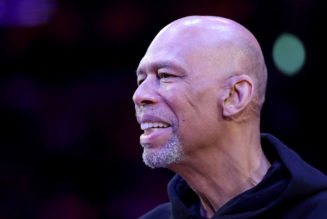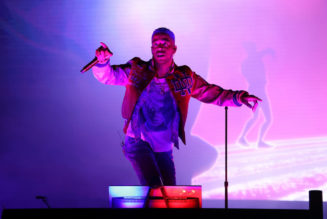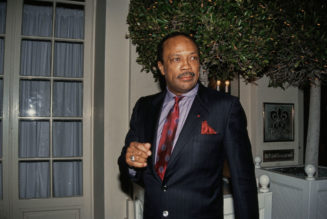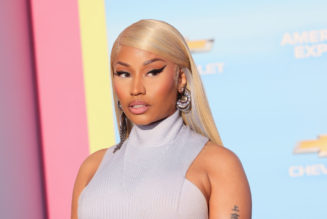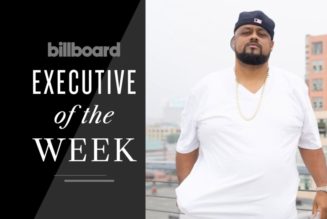Concerts are slowly starting again, but they’re looking considerably different in the pandemic and many clubs are unsure whether they’re worth the risks.
On May 18, TempleLive in Fort Smith, Arkansas, hosted one of the nation’s first socially-distanced concerts with country rock artist Travis McCready of the band Bishop Gunn. In order to prevent the spread of the coronavirus promoters implemented extensive safety protocols: temperature checks at the door, masks on attendees and staff, limited bathroom occupancies and disinfecting fog sprayers, among them.
The venue also had to keep each “fan pod” group of fans who arrived together at least six feet apart with one-way walkways and vigilant staff. It was an unusual sight for Getty Images photographer Kevin Mazur, who flew in from New York to shoot the historic night.
“They handled it very well,” Mazur tells Billboard. “They took every precaution, everyone was social distancing when people were going to the bar, sitting down. The woman taking temperatures, if she saw someone put their hand on the rails, she was immediately wiping down the bars. They were on top of it. They did everything right. They set the blueprint on how a show should be run.”
In compliance with Gov. Asa Hutchinson’s reopening guidelines for Arkansas — where as of Sunday there had been 6,020 cases of COVID-19 and 117 deaths — McCready’s show was reduced to just 20% capacity with 200 attendees in the 1,000-capacity venue. Similar capacity limitations are one of the many guidelines for concert venue reopenings being floated by various state and local governments. While states with fewer cases of the coronavirus like Missouri aren’t regulating the number of attendees, Texas’ reopening plan allowed venues to open at 25% capacity starting last Friday.
“That is our proving ground. That is where we start,” says Edwin Cabaniss, founding member of the Music Venue Alliance-Texas and owner of The Kessler and Heights Theaters. “Restaurants started on May 1 at 25% and on May 18 they proved that they could do this based on the standards the governor set out and the coronavirus didn’t spike based on those standards. Restaurants are now at 50%.”
For venues, promoters, artists and music workers in Texas, 25% capacity is far from ideal financially, but Cabaniss calls it a “path to reopening” after more than eight weeks of closures and economic uncertainty.
“Ultimately, the virus will dictate whether or not we can move forward with higher capacities. Let us get our feet underneath us,” he says. “I would sure rather try to get [25% capacity] exactly right before I go to 50%. And then I would like to get that right before I go to 75% and then 100%.”
AN ADDED FINANCIAL BURDEN: PREP WORK
While restrictions on music venues are starting to ease, not all will be able to handle the logistics mandated under new guidelines. These businesses have been without income for two months or longer and initiating safety protocols like contact-less entry and payment systems, purchasing large amounts of cleaning supplies, and training and personal protection equipment for staff can be cost-prohibitive, especially all at once costly.
Liz Tallent, who owns the Orange Peel in Asheville, North Carolina, and is a member of National Independent Venue Association’s Carolinas precinct, is weary of reopening given the financial burden suddenly placed on these small businesses.
“If you’re just a listening room that holds 200 people, I’m not sure how they are going to afford the kind of investments that they need to make their room safe,” Tallent says. “Everything is going to have to change, even in terms of what we charge for tickets. People are discussing if there will need to be a $5 surcharge that covers gloves and masks for everyone and technology so that we don’t have to touch cash or credit cards. Those are very real conversations that people are having.”
Mike Brown of TempleLive told Billboard before the McCready show they weren’t doing it for financial reasons. “We just wanted to do something to get it back to normal, or close,” he said, noting that their model “may not be for everyone.”
CAN LIMITED CAPACITIES EVER BE VIABLE?
And while TempleLive and other venues across the country may be looking for a clear way forward, Brown pointed out the McCready show’s business model had clear limitations. “There are some financial mechanisms that come into play where it doesn’t make sense for the artist or it doesn’t make sense for us,” he said. “You don’t want to just continue doing things you don’t have a financial gain in… but as long as you get to a point where you break even.”
Brown told Billboard that the Arkansas show was not profitable in a way that could sustain business until larger gatherings are allowed, but was “designed to identify needs and best practices going forward.”
For other venues across the country, it may not be feasible to open up at a reduced capacity with additional safety expenses, leaving many looking at alternative ways to defer costs to move forward such as seeking funding from government agencies.
In the response to the pandemic, this month Washington D.C.-based Music Policy Forum and Sound Music Cities in Austin came together to form a new initiative called Music Cities Together, which launched a 10-city pilot program called Reopen Every Venue Safely. Made up of Los Angeles, Seattle, Cleveland, Albuquerque, Portland, Austin, Chicago, New Orleans, Louisville and Charlotte, REVS is helping to connect music venues with their local health departments to foster reliable communication and collect data on best practices moving forward with a geographically diverse set of cities.
“We don’t know what [reopening] is going to look like. This is not just going to be a project hyping up live music. [The data we collect] is going to say, ‘Here is where we failed. This is where we hit a wall. This is what we wish we had done differently,'” says Music Policy Forum co-founder Michael Bracy.
REVS is looking at financial assistance from local health departments to purchase sanitizing material in bulk for a consortium of venues, as well as government support to train staff on new safety procedures. Bracy says, “Part of the conversation is going to be whether venues are going to be able to tag on with other industries to be able to do procurement strategies and buying stuff at scale. Are corporate sponsors or other donors able to sponsor some of these costs?”
Cabaniss in Texas agrees that “there is going to be a reallocation of resources until we get up to a certain point.” For example, he says venues can implement strategies like using fewer bartenders for lower capacity shows to meet demand and move that staff to sanitation positions. And while not all staff will want to take sanitizing positions, Cabaniss is personally offering a 150% pay increases for those positions and says he will take the first bathroom shift when his venues reopen.
He also acknowledges that, in order to make reduced capacity shows work, everyone from the artist to the venue owner is going to have to renegotiate contracts for the remainder of the pandemic.
“I don’t know that 25% is viable, but what I do know is that if we are closed that is not viable,” says Cabaniss, who believes his venues like the 500-person The Kessler in Dallas can open in late June or early July. “It is going to be a minute before the Rolling Stones decide to rebook their tour and come to the Cotton Bowl [stadium in Dallas]. But we have a lot of artists, we have a lot of venues. There are a lot of artists who can come in and do a mini tour of Texas and actually make a living in the mid to small-sized businesses while we are waiting this thing out.”
THINK LOCAL
Regional tours could limit the risk of spreading the coronavirus to areas with fewer cases and can cut down on costs for bands who don’t have to travel or travel far to play one off shows. Venues can also work with locally-based bands that normally tour nationally to do ‘underplay’ shows at smaller venues for smaller capacities. Intimate shows from big groups could serve as a special thank you to hometown crowds and tickets could go for a higher premium due to the show’s exclusivity. It’s something Tallent expects to see tested, but says points out it’s a tricky proposition: “How much and what is an appropriate way to do it? I don’t know,” she says, “Venues are certainly sensitive to the fact that a lot of people are unemployed right now.”
Building consumer confidence to return to live shows is an additional hurdle for venues to overcome. And while promoters may be able to help supplement concert revenue with paid livestreams — which have boomed 50% in popularity during the pandemic, according to Bandsintown statistics — with so many questions still circulating about COVID-19 and a lack of consistent guidelines from the federal government, customers have indicated many have a new reluctance to attend live events. In a Canadian survey conducted by Abacus Data, only 22% of frequent concertgoers and 12% of the general population say they will attend concerts within a few weeks of their return. Both the Abacus Data survey and a Live Nation survey of live music fans found that about 10% of concert goers believe they will probably never return to venues and festivals.
“The audience engagement piece is so important. It is not only safety concerns, it is, ‘What is my experience going to be like? Do I want to do that? Does that sound fun to me?'” says Bracy, who adds REVS is also working on marketing best practices to help fans feel comfortable returning to live shows. “Communicating what the experience is going to be and is that going to be something that is of interest as an experience beyond the safety concerns.”
As venues reopen, Tallent says there is a paramount trust issue, where venues must prove themselves to fans — with many livelihoods depending on it.
“We cannot afford to try some experiment of opening that doesn’t work and then have to close again in two weeks because people didn’t feel safe or people weren’t respecting the guidelines that we set about staying six feet apart,” she says. “It is our responsibility to be one of the most upstanding model businesses in our community, because we are really high profile. We don’t want to risk anything looking like we were irresponsible or cavalier or we didn’t think through things carefully enough. Nobody wants to be the cautionary tale of the nightclub in Korea.”



